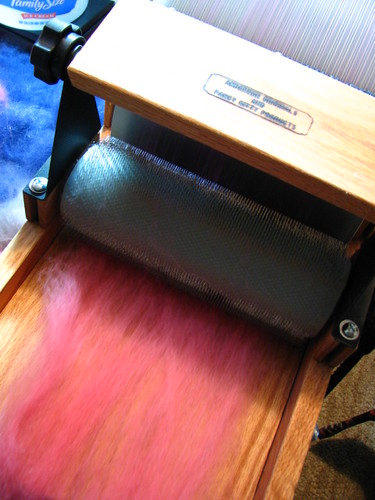Last fall (not this year, 2008) I found the most wonderful Anne Klein coat. Deep green….mossy and brown, A-line, elegantly simple top stitching, chunky buttons. Oh, and get this…..60% Angora and 40% wool. Soft, very warm, simple, and on an incredible discount.
The problem? No scarf, hat, mittens…..worthy of this fantastic garment. So the coat spent its first winter in the closet. Insane, perhaps. My intention was to dye something fabulous to go with the coat. Never happened.
Earlier this year, I stepped into a crafty type store to pick up some goodies to go with a fiber club shipment, and here was the Paton’s Shetland Chunky. Although I thought the bright green was perhaps a shade too bright, I bought it. Surely, now all I had to do was knit it up, right?
My first attempt was just a simple 1×1 rib scarf on the knitting machine. Bleah. Frog. So hand knitting it was……here’s the Wave drop stitch scarf I tried:
I didn’t much care for that either. How about crochet? I consulted my books, and making a 5 chain net from it seemed like that would work. I worked on this while we were on our Thanksgiving travels.
Seems ok, right? Mr. Tiger and the cubs deemed it just dandy. The picture below really shows the problem though……

Yes, we have the dreaded blobby side and then the diminishing helix side. Argh!!
Which then led to something I’ve been putting off for a long time……..

This here is a Beka frame loom. I picked it up at an auction a few years ago, along with many many back issues of Handwoven, tons of books for ‘big looms’, plus a variety of bobbins, a winder, and a Schacht shuttle. Why did I get all that? Well…..in the lot was a big handmade cherry warping mill, and I was very much at the time into dyeing striping yarn (still am, but always searching for a more efficient way of doing it). So I dutifully shelved the books and mags, and tucked the loom away for a rainy day. The bobbins and winder have come in quite handy with my spinning….letting me wind off of my wooden wheel bobbins and redistribute the twist by winding it across the room.
Anyway, I’ve been lurking on the Rigid Heddle group on Rav, and by chance saw a link to direct warping. Eureka! Surely the yarn would look better woven, and direct warping looked so easy!!

So here’s my start. I actual un-wove all this, added a few more warp strands, and started over. Overall, I spent about 6 hours on this project, which I think isn’t bad considering I was learning as I went.


So here it is. My selvedges are wonky here and there (more noticeable when that pesky light green was on the edge), and if held straight it has a bit of a curve, but over all good enough for me to wear with pride. Now I’m looking for a sewn hat and mittens pattern, since I have enough yarn to fabric for that, too.
So now I’m trying to decide why I resisted this fiber craft for so long. It is easy and quick, makes great results, and will be a fabulous way to use the yarn I spin. Perhaps I didn’t want to follow this new weaving trend, or felt Mr. Tiger wasn’t ready for a new hobby to appear in the house. Either way, the breakthrough is going to cause some serious damage to my pocketbook. I’ve been thinking our living room needs a nice 20″ Flip.
It all started with a coat.
























































